Many chicken breeders most widely prefer raising Frizzle chicken. This breed is a rare species and has now become a point of attraction for many chicken breeders.
If you are interested in raising this rare chicken breeds then you must know all about this breed so that you can raise it efficiently and correctly.
In this Frizzle chicken complete breed guide, you will gather all the information related to this unique chicken breed.
Here you will get all about Frizzle chicken like facts, history, color, temperament, eggs, appearance, characteristics, benefits, problems, and pictures.
What is Frizzle Chicken?
Frizzle is a chicken breed with curled plumage. They have hair like feathers all over the body. Frizzle are lovely, cute chicken breeds.
You may see frizzle genes in a few popular chicken breeds like Cochin, Polish, Plymouth rocks, Japanese Bantam, Araucana, Orpington and Silkie chicken.
If you breed a Silkie chicken with Frizzle, you will get Sizzle chicken. You will see crests like Silkies and five toes in Sizzle, but they have almost the same type of character as Silkies.
Frizzle chicken is a distinct breed whose origin was found to be in European countries and Australia. They are funny, conspicuous, and lovable.
It is most definitely a chicken, but with a very unusual look and some special needs to go with the look. This chicken breed has been in nature since the 1600s but has recently gained popularity.
In any portion of the world, people love this chicken because of its cuddly demeanor and humorous appearance.
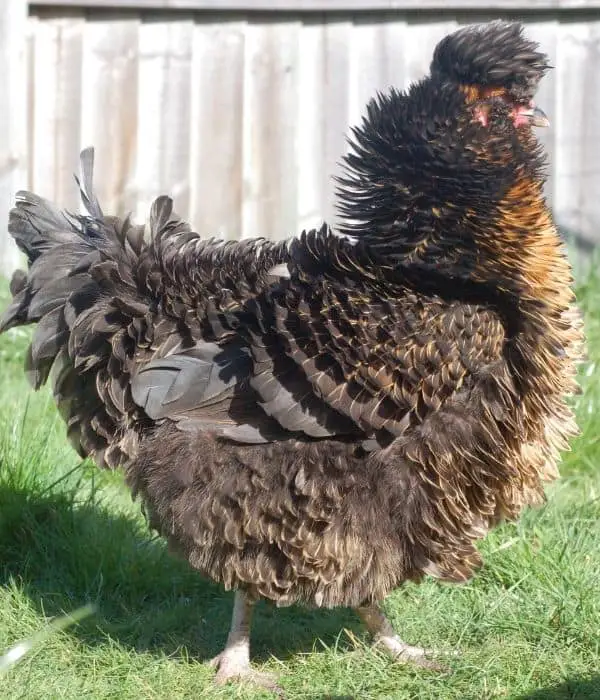
History of Frizzle Chicken
Frizzle chicken is not a new breed; it was mentioned in the 1600s, but its history is unknown. In some recent research, it is said that it originated in Asia. They are also predominantly found in India.
The gene that determines its frizzle character has arisen from the East Indies and Far East region. As this unusual bird gained popularity, the birds were brought to the western countries as curiosities and breeding stock were from the east in the 18th century.
Frizzle chicken is recognized in nine European countries–
- Belgium
- Czech republic
- France
- Germany
- Ireland
- Italy
- Poland
- Sokovia
- United Kingdom
Lifespan of Frizzle Chickens
We all now know the frizzle gene is found in various species of chickens like Cochins, Silkies, Japanese Bantams, Plymouth Rocks, Polish, Orpingtons, etc. So, the life expectancy of Frizzle chickens is not specific, but yes they have 6-8 years of lifespan on average.
Eggs Production
Frizzle chicken’s eggs will vary depending on their breed. The average weight of the Frizzle chicken eggs is about 58-60 gm and has a light brown shell.
Cochin Frizzle Chicken- These are not the best egg layers. On average, they will lay 180-200 eggs in a single year. They lay their eggs in the winter month. The eggs are small to medium and are brown.
Silkie Frizzle Chicken (Sizzle)- Sizzle chicken lay about 120 eggs per year on average. They start their egg-laying in January, contributing sizably to the pantry.
Japanese Bantam Frizzle Chicken- This breed is horrible in terms of egg-laying as they lay only one egg per week. Japanese bantam lay small eggs. You can get brown or cream color eggs from them.
Plymouth Rock Frizzle Chicken- This Plymouth Rock breed does its best egg-laying in the first three years of life, and then it declines. Start laying from 18 to 22 week of age.
On average, Plymouth Rock Frizzle lay around 220-250 eggs per year or five per week. These eggs are large and brown.
Polish Frizzle Chicken- Polish bantam lay around 200 on average per year. They need time to get they can produce a consistent amount.
Orpington Frizzle Chicken- On average, Orpington Frizzle Chickens hen lays four eggs per week. The eggs are large and light brown.
Read the list of best egg-laying chickens.
Frizzle Chicken Temperament
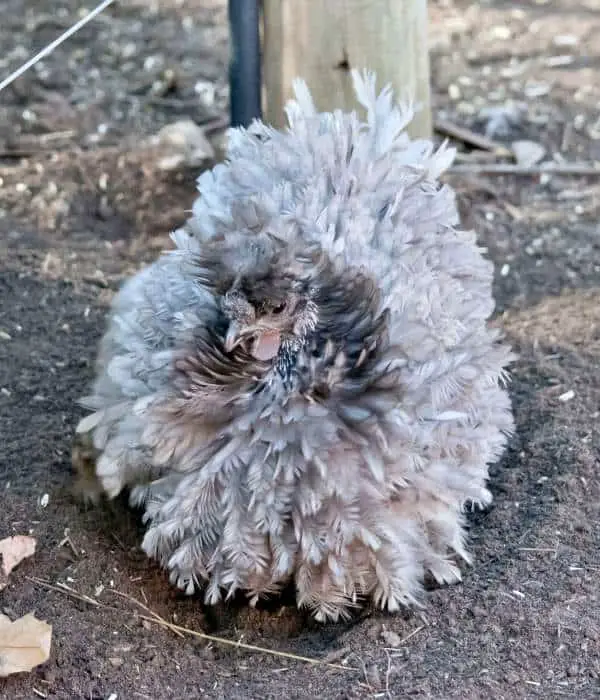
The Frizzle chickens are adorable, friendly, and have a gentle disposition. This chicken breed is very docile, and they tolerate the handling very well.
With this most lovable and fancy breed, you will experience a wide range and spectrum of temperaments. The temperament of the Frizzle chicken breed mainly depends upon the adult breed.
Frizzle is an intriguing ornamental breed that requires pretty high maintenance. It is the golden doodle of the chicken world. This is a beautiful breed with hygienic needs and intense grooming.
Color, Size, Appearance, Characteristics of Frizzle Chicken
Color and Appearance
The only difference that this Frizzle chicken breed has is the curled feathering appearance, and this chicken will take the shape of the species. There are several colors; buff, black-red, brown-red, blue Columbian, cuckoo, duck wing, Pyle, red, spangled, and white.
Frizzles appear as a bundle of wild curly feathers with legs- much like a feather buster. Frizzle chickens look curly and tidy. They may look soft, though, not spiky.
The Frizzle gene for the curling of the feather is incompletely dominant over standard plumage; not all the members of the breed have frizzle feathers.
Fizzles are heterozygous for the gene, and their offspring inherit the gene from their parents in the 1:2:1 ratio.
- 50% Frizzle Chickens are heterozygous, so they have a curl feather appearance like their parents.
- 25% have normal feathers.
- Other 25% have over-frizzled feathers.
This frizzle chicken’s unique feature is that they have a single comb, and they have no feathers in the shanks and have cleaned legs. This chicken breed is a good forager and is hardy too.
The club of Great Britain recognizes nineteen colors for both standards and bantam size. Australian poultry standards recognize black, blue, buff, white, Columbian red, and other recognized colors.
Size
The weight of the Frizzle Chicken varies, and it depends on the breed of the Frizzle. Its size differs slightly, and the standard bird weight must be around 8 lbs for the male chicken and 6 lbs for the female one.
Characteristics
It is a bird having complete curly plumage and has a compact aspect. The Frizzle chicken has broad feathers, and they are long and hairy.
This is a fast-growing chicken. After hatching, the chicks appear to have typical plumage, but soon the wing feathers arise; they curl outward.
These are calm birds and are good layers and can’t fly very well. They are classified as heavy breeds and are only considered display birds.
Frizzles are perfectly adapted to roam freely in open areas.
Benefits of Raising Frizzle Chicken
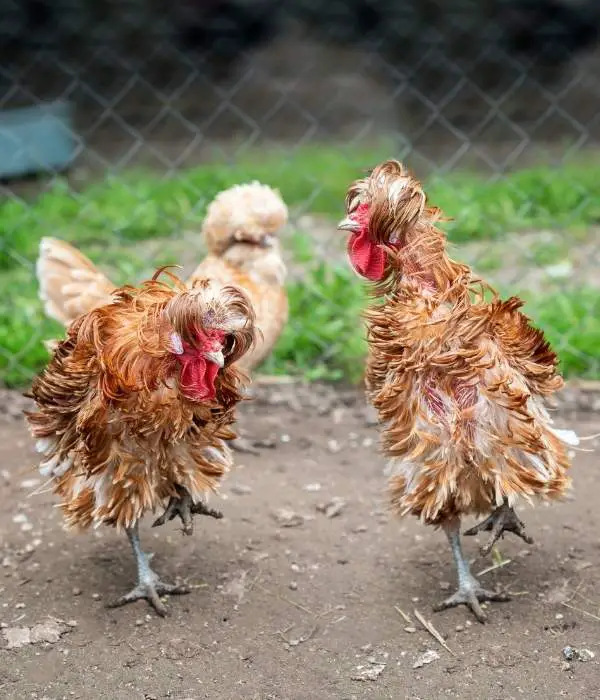
This chicken breed has a calm nature, and it’s easy to tame this chicken breed. They have a unique, fierce appearance. They are crazy and behave in a relaxed, laid down manner.
Frizzle chickens are good brooders and attentive mothers too. Although they have ridiculous feathering, they still show their love and care for their younger ones.
Since these chickens are standard size, so they don’t need a ton of extra space in the coop for them. They need about 2-3 sq. ft. space per bird inside the coop and 6-10 sq. ft. in a kennel run.
Problems in Raising Frizzle Chicken
This Frizzle chicken can’t fly, which is why they require lower perches that are set down at a shorter height.
The birds are so small, and the feather pattern makes them impossible to fly. As they can’t fly up, these birds are more prone to danger from the predator.
Their feathers are not a fantastic insulator, as other chickens’ feathers used to be. So, we need to take proper care during winter.
Inclement weather like heavy precipitation poses difficult situations for Frizzle Chickens. The dense featherings on the head interfere with their vision.
As a result, they couldn’t see the predator and face danger.
Care Guide and Tips of Raising Frizzle Chicken
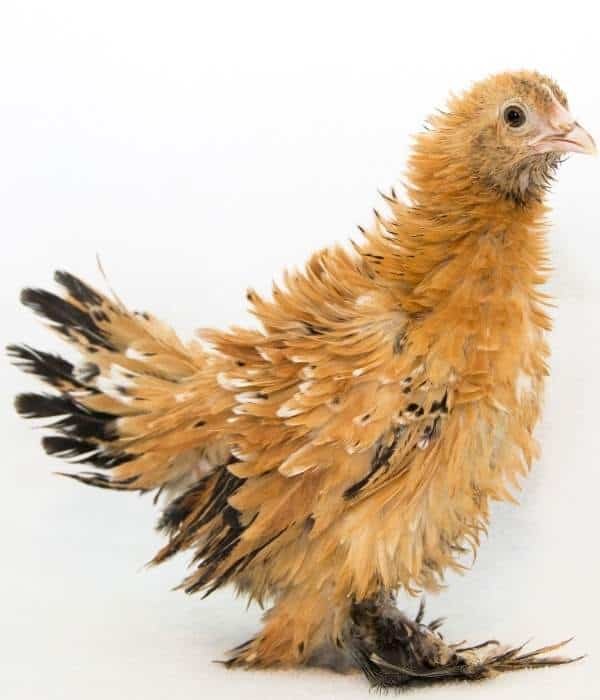
This Frizzle chicken breed requires care and attention similar to that of regular chicken. Below are three basic tips for this lovely –
Shelter or Coop Management
Frizzles can either be confined or free-range. But most of the chickens prefer outdoor foraging. It’s recommended to confine them to lower the risk of illness and keep them safe from predators.
These chickens are hardy because they go well in winter, and they protect themselves from the wetness. Frizzles are an average size breed, so that they will need adequate space. Here is our guide on keeping chickens warm in winter.
Feeding Guide
Frizzles do not require a specific diet or exceptional food. We should give them high-quality food that nutrients will help their immune system, promoting growth and production.
Since these birds are confined, they have a lower food cost and if you own a farm. You can also use some chicken scratch occasionally.
Predation and poor weather can affect chickens’ health. Water should be clean and fresh. The amount of water they need will depend on the chicken itself. Be sure to keep filling water as it gets low.
Chicken Breeding
Frizzles is a good domestic chicken which you can raise easily. They will produce enough eggs to fertilize if you have a decent number of roosters and hen.
The general rule is to have ten hens of one rooster. Here is our guide on how many hens per rooster?
Summary
Frizzles are charming and delightful. Frizzles are a non-aggressive bird content to either free-range or hang out with other girls in confinement.
They are hard to beat as exhibition birds. These have many offers in the way of gentle, quiet companionship.
Frizzle chickens are so well-behaved. Many farmers raise frizzles like pet chickens.
I hope you like this breed guide on the delight to look, non-demanding, and perpetually happy Frizzle chicken.
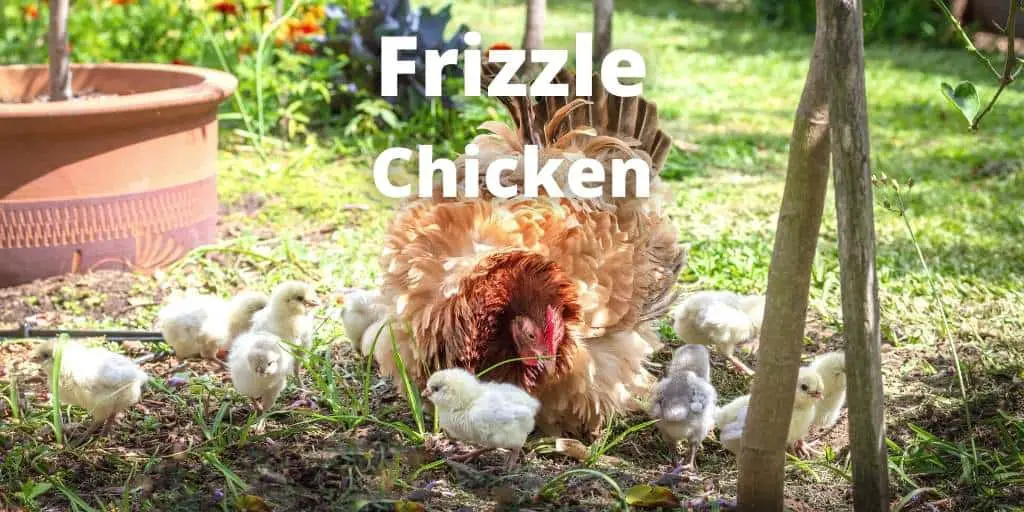


Thanks for all the nice information. I love my fizzles. I have had 5 months. I had a sweet girl named Fluffy, but the dog killed her. Now, I protect the others well. Thanks again, TW
Would be good to have some information on how to tell a pullet from a cockeral.